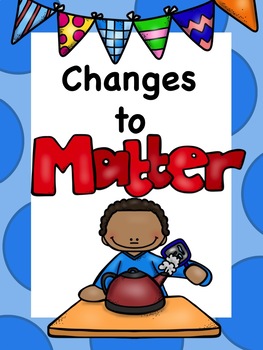Changes in Matter NGSS Aligned
Mary Beth White
196 Followers
Grade Levels
1st - 3rd
Subjects
Resource Type
Standards
CCSS1.MD.C.4
CCSS2.MD.A.1
CCSS2.MD.A.3
CCSS2.MD.D.9
CCSS3.MD.A.2
Formats Included
- PDF
Pages
39 pages
Mary Beth White
196 Followers
Description
This is a 39 page completely NGSS aligned changes of matter bundle. It is everything you need to teach the NGSS standards for changes of matter. This packet will spark every student's excitement and understanding about science.
This unit covers NGSS standards:
2-PS1-3
2-PS1-4
Include in this bundle is my Changes of Matter unit.
It includes:
Changes to Matter
12 Changes to Matter Vocabulary Cards
2 Matter Can Change Activities
Observing All Types of Matter Investigations and Printables
The Disappearing Ice Cube
Water in the Mirror
The Disappearing Snowman (can do any time of the year)
The Root Beer Float Challenge
The Hot, Warm, and Cold Race
The Butter Challenge
The Mini Marshmallow Challenge
Engineering
Hot Chocolate Super Hero Project
Popsicle Super Hero Project
Thanks for looking and Happy Teaching!
This unit covers NGSS standards:
2-PS1-3
2-PS1-4
Include in this bundle is my Changes of Matter unit.
It includes:
Changes to Matter
12 Changes to Matter Vocabulary Cards
2 Matter Can Change Activities
Observing All Types of Matter Investigations and Printables
The Disappearing Ice Cube
Water in the Mirror
The Disappearing Snowman (can do any time of the year)
The Root Beer Float Challenge
The Hot, Warm, and Cold Race
The Butter Challenge
The Mini Marshmallow Challenge
Engineering
Hot Chocolate Super Hero Project
Popsicle Super Hero Project
Thanks for looking and Happy Teaching!
Total Pages
39 pages
Answer Key
N/A
Teaching Duration
N/A
Report this resource to TPT
Reported resources will be reviewed by our team. Report this resource to let us know if this resource violates TPT’s content guidelines.
Standards
to see state-specific standards (only available in the US).
CCSS1.MD.C.4
Organize, represent, and interpret data with up to three categories; ask and answer questions about the total number of data points, how many in each category, and how many more or less are in one category than in another.
CCSS2.MD.A.1
Measure the length of an object by selecting and using appropriate tools such as rulers, yardsticks, meter sticks, and measuring tapes.
CCSS2.MD.A.3
Estimate lengths using units of inches, feet, centimeters, and meters.
CCSS2.MD.D.9
Generate measurement data by measuring lengths of several objects to the nearest whole unit, or by making repeated measurements of the same object. Show the measurements by making a line plot, where the horizontal scale is marked off in whole-number units.
CCSS3.MD.A.2
Measure and estimate liquid volumes and masses of objects using standard units of grams (g), kilograms (kg), and liters (l). Add, subtract, multiply, or divide to solve one-step word problems involving masses or volumes that are given in the same units, e.g., by using drawings (such as a beaker with a measurement scale) to represent the problem.





